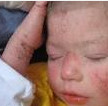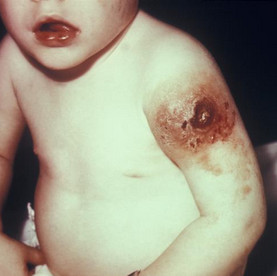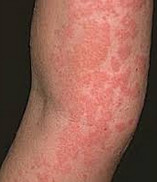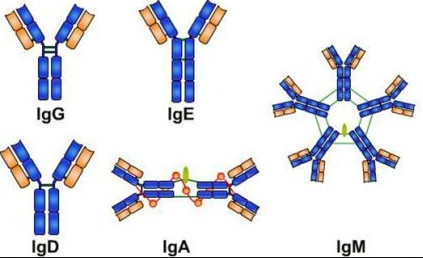Immunity protects human health. With well-functioning work immune system It is very difficult for unwanted guests (germs, viruses, etc.) to enter the body. In the event of a hit, a timely reaction occurs, and the enemy is neutralized, and after neutralizing the pathogens, the attacks of the immune system are stopped in time, the necessary entries are made in the “dossier” of the strangers, the “native” tumor cells of the body are also detected and destroyed in a timely manner, healthy ones are protected. The person is healthy, happy, full of strength. When the immune system malfunctions, various diseases occur:
1. Immunodeficiency diseases– arise due to the ineffective and slow functioning of the immune system, when the immune system or its individual parts are impaired or completely absent due to the fact that the principles of the immune system are violated. These diseases are divided into congenital (primary) and acquired (secondary). Congenital immunodeficiency diseases- develop as a result of malfunctions of individual genes caused by hereditary factors. These are diseases such as: congenital aplasia of the thymus and parathyroid glands, chronic granulomatosis, Wiskott-Aldrich syndrome, children of patients from birth lack B-row and T-row lymphoid stem cells, and there are no pre-B-lymphocytes in the bone marrow. In cases of congenital immunodeficiency, it is delayed physical development body, and various severe diseases (often fatal) easily occur. Acquired immunodeficiency diseases develop as a result of fungal, bacterial (leprosy, cholera), viral (influenza, measles, hepatitis) infections, radiation exposure, chemotherapy, and may also be due to the use of antibiotics, corticosteroids, cytostatics. By the way, ionizing radiation affects the main organ of the immune system - lymphatic tissue, which greatly undermines the functioning of the immune system. Acquired immunodeficiency diseases are AIDS, hepatitis, diabetes, cirrhosis, uremia, etc. Immunodeficiency can also be an independent disease if the cells of the immune system are damaged by a viral agent.
2. Autoimmune diseases– occur when the immune system accepts its own cells of tissues and organs as foreign and destroys them. That is, it is a disease during which the immune system destroys its own organs and tissues. Autoimmune diseases are also called systemic, since during their course the entire system of organs and tissues of the body is affected. The most well-known autoimmune diseases are: systemic lupus erythematosus, autoimmune thyroiditis (Hashimoto's thyroiditis), Graves' disease (diffuse toxic goiter), multiple (multiple) sclerosis, etc.
3.  Allergic diseases. The term “allergy” comes from the Greek: “allos” - different, different, and “ergos” - action. Literally it means “doing things differently.” Allergic diseases are a consequence of the body's hyperimmune response to the influence of certain environmental factors (chemicals, microorganisms and their metabolic products, foods, plants, etc.); they are also called allergens. Allergic diseases can be caused by many factors, including environmental pollution, chemical products, the use of antibiotics and other medications, stress, poor nutrition, physical inactivity, and abuse of cigarettes and alcohol. Allergens are also the result of various compounds; they are divided into those that enter the body from external environment, they are called exogenous allergens and those that are formed inside the body are autoallergens or endogenous allergens. The most common allergic diseases are: bronchial asthma, hay fever, urticaria, contact dermatitis.
Allergic diseases. The term “allergy” comes from the Greek: “allos” - different, different, and “ergos” - action. Literally it means “doing things differently.” Allergic diseases are a consequence of the body's hyperimmune response to the influence of certain environmental factors (chemicals, microorganisms and their metabolic products, foods, plants, etc.); they are also called allergens. Allergic diseases can be caused by many factors, including environmental pollution, chemical products, the use of antibiotics and other medications, stress, poor nutrition, physical inactivity, and abuse of cigarettes and alcohol. Allergens are also the result of various compounds; they are divided into those that enter the body from external environment, they are called exogenous allergens and those that are formed inside the body are autoallergens or endogenous allergens. The most common allergic diseases are: bronchial asthma, hay fever, urticaria, contact dermatitis.
You can write a lot about diseases of the immune system, but even what is described above is quite enough to understand how many health problems can result from malfunctions of the immune system. As you and I know, the best cure for a disease is its prevention. Measures such as an active lifestyle, abstaining from the abuse of tobacco, alcohol, overeating, and avoiding stressful situations if possible. It is also necessary to give the “right” to the immune system to do its job itself, and not to replace its work with antibiotics at the first “sneeze,” since you and I know that if someone or something does not fulfill its duties, then it will not become effective and fails quickly.
These actions will provide your immune system with an invaluable service, no matter how cliché it may sound, but this is the basis of the foundations of health. But with the current environmental, genetic and modern psychological situation and the emergence and strengthening of resistance of more and more new types of viruses and microbes, human immunity is weakened every year. Some people have no innate immunity at all (due to the fashion of “scientific luminaries” not to bring the child to the mother in the first days of life, thereby depriving him of colostrum with which innate immunity is transmitted), there was a need for a drug that could work not with diseases , but with immunity. And after 50 years of research, 11 world symposiums, scientists finally managed to isolate transfer factors (transfer factors) from cow colostrum and a drug appeared Transfer factor the work of which is fundamentally different from the work of all currently known drugs and has no analogues in the world.
the work of which is fundamentally different from the work of all currently known drugs and has no analogues in the world.
Transfer factor does not cure diseases, it supplies our immune system with information on how to cope with the invasion of foreign microorganisms, stimulates the immune system if necessary and regulates the strength of the body's immune response. In addition, the drug does not have side effects and is recommended for use by people of all ages for the prevention and assistance in the treatment of many immune and other diseases, having undergone a huge number of clinical trials in many countries of the world (including in Russia, see letter from the Ministry of Health). Transfer factor can become your reliable assistant in restoring and maintaining good immune function.
Like all other systems of the human body - respiratory, circulatory, bone and others - the immune system can get sick. Previously, specialists were mainly interested in the protective role of immunity, but now important attention is paid to the insufficiency and disorders of the immune system itself. The immune system not only protects the body, but if it is disrupted it can seriously damage it.
Main groups of immune system disorders:
1. Immunodeficiencies(congenital or acquired absence and or weakening of one of the links of the immune system)
Immunodeficiencies make the body defenseless against germs and viruses. If the immune system is weak, even harmless bacteria that live in our bodies for decades can cause serious illness. In such cases, antibiotics and antiviral drugs help the body slightly, but do not cure it completely.
With prolonged stress and disruption of regulation, the immune system loses its protective significance and its reverse “dark” side appears. Failure of one or another specific immune mechanism leads to the development of immunodeficiency - a disease caused by insufficiency of the immune system. There are clear differences between cellular and humoral immunodeficiency.
Primary specific immunodeficiencies, in which cellular immune factors are predominantly damaged, include about two dozen different diseases. They are based on cellular functional deficits and cellular deviations from the norm. Severe combined immunodeficiencies cause the most profound cellular defects. Patients suffering from them have neither T- nor B-cells. These diseases are hereditary.
 In such patients, tonsils are often not found, and the lymph nodes are extremely small (or completely absent). Paroxysmal cough, chest depression when breathing and wheezing, a tense atrophic abdomen and aphthous stomatitis indicate chronic pneumonia. Already in the first months of life, persistent development of lung infection, candidiasis of the upper pharynx, esophagus and skin, chronic diarrhea, exhaustion and growth retardation begins. Such gradually progressive symptoms lead to death within 1-2 years.
In such patients, tonsils are often not found, and the lymph nodes are extremely small (or completely absent). Paroxysmal cough, chest depression when breathing and wheezing, a tense atrophic abdomen and aphthous stomatitis indicate chronic pneumonia. Already in the first months of life, persistent development of lung infection, candidiasis of the upper pharynx, esophagus and skin, chronic diarrhea, exhaustion and growth retardation begins. Such gradually progressive symptoms lead to death within 1-2 years.
Children whose bodies genetically do not synthesize antibodies are extremely vulnerable to pneumonia and other infections. Previously, such children died. Today, with careful care and skillful treatment of babies with immunoglobulins and antibiotics, they remain alive, but usually after a few years they develop rheumatoid arthritis and symptoms of other autoimmune diseases.
Congenital immunodeficiencies are more correctly called primary. In such cases, the growth and physical development of the body is delayed, and serious illnesses (often fatal) easily occur.
Immunological deficiency of primary origin is usually understood as the genetically determined inability of the body to produce one or another part of the immune response. Primary immunodeficiencies are also called congenital, since they appear soon after a person is born and have a clearly defined hereditary nature. Examples of congenital immunodeficiency conditions are hemophilia, some types of deafness and dwarfism.
 A child born with a congenital defect of the immune system is usually no different from a normal newborn. The first weeks of life (as long as antibodies received from the mother, as well as with the first mother's milk, circulate in his blood) he looks quite healthy. But very soon the hidden trouble appears. Repeated infections begin - pneumonia, purulent skin lesions, etc. The child begins to lag behind in development, he is weakened, often cannot walk, and is intellectually inferior. Many forms of primary immunodeficiencies are usually complicated by the development of malignant tumors. Acquired immunity defects are often called secondary, since they arise and develop after some primary exposure. For example, ionizing radiation, when exposed to the body, destroys the main organ of the immune system - lymphatic tissue, and sharply weakens the immune system. A significant group consists of secondary immunodeficiency conditions that arise as a result of damage to the immune system by pathological processes, malnutrition, and hypovitaminosis.
A child born with a congenital defect of the immune system is usually no different from a normal newborn. The first weeks of life (as long as antibodies received from the mother, as well as with the first mother's milk, circulate in his blood) he looks quite healthy. But very soon the hidden trouble appears. Repeated infections begin - pneumonia, purulent skin lesions, etc. The child begins to lag behind in development, he is weakened, often cannot walk, and is intellectually inferior. Many forms of primary immunodeficiencies are usually complicated by the development of malignant tumors. Acquired immunity defects are often called secondary, since they arise and develop after some primary exposure. For example, ionizing radiation, when exposed to the body, destroys the main organ of the immune system - lymphatic tissue, and sharply weakens the immune system. A significant group consists of secondary immunodeficiency conditions that arise as a result of damage to the immune system by pathological processes, malnutrition, and hypovitaminosis.
Most diseases are accompanied by immunological deficiency to one degree or another. However, only in a number of cases does it become a factor in the continuation of the disease. Thus, immunological deficiency occurs after viral infections- flu, measles, hepatitis. It can also be a consequence of the use of corticosteroids, cytostatics, antibiotics, or radiation. Acquired immunological deficiency syndrome can also be an independent disease caused by direct damage to cells of the immune system by a viral agent.
2. Autoimmune conditions
Conditions in which the immune system mistakenly attacks its own organs and tissues. Immune diseases also include processes caused by immunopathological reactions that damage the body’s own tissues. The initiators of these reactions can be both foreign and self-antigens. In the first case, a separate group consists of allergic diseases.
 Autoimmune reactions are characterized by the appearance of so-called aggressive autoantibodies in the body. There are autoimmune processes induced by foreign agents that are similar to host tissues. Many bacterial and viral antigens have these properties. The immune response to foreign antigens often leads to the elimination of the “loyal attitude” - the removal of tolerance to one’s own antigens and the development of an immunopathological process. The immune system recognizes foreign substances and promotes neutralization in time negative aspects their actions. However, does the immune system always correctly distinguish harmful from beneficial? And is it doing the right thing when implementing its main function, which is that everything foreign in the body must be destroyed? The so-called “recognition error” phenomenon occurs in the body, which consists in the fact that the immune system reacts to indifferent and often even beneficial factors as harmful, mobilizing its protective functions against them.
Autoimmune reactions are characterized by the appearance of so-called aggressive autoantibodies in the body. There are autoimmune processes induced by foreign agents that are similar to host tissues. Many bacterial and viral antigens have these properties. The immune response to foreign antigens often leads to the elimination of the “loyal attitude” - the removal of tolerance to one’s own antigens and the development of an immunopathological process. The immune system recognizes foreign substances and promotes neutralization in time negative aspects their actions. However, does the immune system always correctly distinguish harmful from beneficial? And is it doing the right thing when implementing its main function, which is that everything foreign in the body must be destroyed? The so-called “recognition error” phenomenon occurs in the body, which consists in the fact that the immune system reacts to indifferent and often even beneficial factors as harmful, mobilizing its protective functions against them.
Thus, the immune system may mistakenly attack the hair roots, considering them foreign or harmful to the body. Damage to the hair roots due to such an erroneous attack is considered one of the causes of premature baldness.
3. Allergies
Allergy - immunity "topsy-turvy - topsy-turvy." As a result of the action of the antigen (allergen), the production of antibodies begins and the formation of the allergen-antibody complex. In this case, immunity manifests itself not as a protective reaction, but as the development of increased sensitivity to antigens. This condition is not yet an allergy, but it can be compared to a gun with the safety off.
There is no specific mechanism for the allergic reaction. This is immunity, but accompanied by the clinical manifestation of allergies.
4. Diseases of the immune system.
Diseases of the immune system include infectious diseases of the immune system organs themselves - AIDS, infectious mononucleosis
5. Malignant tumors of the immune system organs(thymus gland, lymph nodes, etc.)
Immune system diseases
A-Z A B C D E F G H I J J K L M N O P R S T U V X C CH W SCH E Y Z All sections Hereditary diseases Eye diseases Children's diseases Male diseases Sexually transmitted diseases Women's diseases Skin diseases Infectious diseases Nervous diseases Rheumatic diseases Urological diseases Endocrine diseases Immune diseases Allergic diseases Oncological diseases Diseases of the veins and lymph nodes Hair diseases Dental diseases Blood diseases Breast diseases ODS diseases and injuries Respiratory diseases Digestive diseases Heart and vascular diseases Colon diseases Ear, nose and throat diseases Drug problems Mental disorders Speech disorders Cosmetic problems Aesthetic problems
Immune system diseases include pathological conditions that develop against the background of changes in the effector mechanisms of immunity. Diseases of the immune system are classified taking into account the activity of immune reactions: in the case of a hyperreaction to external allergens, allergic diseases develop; in the case of a perverted reaction to one’s own (endogenous) tissue antigens, autoimmune diseases develop. When the immune system is hyporesponsive, immunodeficiency states occur, in which the body becomes vulnerable to various types of infections. The main organs of the immune system are the bone marrow, thymus, spleen, tonsils, lymph nodes, and lymphoid tissue of the mucous membranes.
Diagnosis and treatment of diseases of the immune system are carried out by doctors of various specialties: allergic pathology and immune deficiency are in the field of view of allergists-immunologists, autoimmune diseases (depending on the leading syndrome) are in the competence of rheumatologists, endocrinologists Louis-Bar syndrome, Wiskott-Aldrich syndrome etc. Secondary immunodeficiencies can develop against the background of infectious, lymphoproliferative, metabolic diseases, intoxication, irradiation, or taking medications (immunosuppressants, corticosteroids). When they occur, the cellular and/or humoral immunity and the phagocytosis system may be damaged. The best known form of secondary immunodeficiency is AIDS (HIV infection).
Common manifestations that accompany various immunodeficiencies are recurrent infections - pneumonia, urinary tract infections, meningitis, generalized candidiasis, herpes, furunculosis, etc. Immunodeficiency states are often combined with allergic diseases - eczema, Quincke's edema. Today it has been proven that congenital defects or acquired deficiency of any immune factors play a leading role in the development of many cancers. Patients with severe immune deficiency often die from opportunistic infections.
To identify or confirm immunodeficiency, a special laboratory study of the immune status is necessary: determination of the number and morphology of lymphocytes, the content of immunoglobulins in the blood serum, study of the complement system, determination of specific antibodies, etc. A biopsy of the lymph nodes, chest radiography, ultrasound of the thymus and spleen. Treatment of diseases of the immune system that occur with immunological deficiency involves replacement therapy (administration of immunoglobulins, serums, bone marrow transplantation), immunocorrection, immunomodulation.
Autoimmune disorders constitute a special category of immune system diseases. In this group of diseases, cells of the immune system exhibit autoaggression towards the tissues of their own body. The prevalence of autoimmune diseases is extremely high - they affect about 5-7% of the world's population. Diseases of the immune system with an autoallergic mechanism are divided into organ-specific - in which autoantibodies are directed against a specific target organ (autoimmune gastritis, autoimmune thyroiditis, autoimmune hepatitis, etc.), non-organ-specific - in this case autoantibodies can attack different organs and tissues (scleroderma, SLE, rheumatoid arthritis, etc.) and mixed.
Triggers that launch a cascade of immunopathological reactions can be bacterial and viral infections, radiation exposure, medicinal and toxic substances, and stress. A number of autoimmune diseases are caused by hereditary factors. Many immune system diseases in this group are characterized by joint and muscle pain, skin rash, weight gain or loss, fatigue, increased bleeding or a tendency to thrombosis, fever, and muscle weakness. Most autoimmune diseases have a steadily progressive course, and without appropriate treatment they can lead to severe disability.
The most valuable methods for diagnosing autoimmune diseases are laboratory tests aimed at identifying autoantibodies to various tissues, circulating immune complexes, acute phase proteins, components of the complement system, and genetic markers in the blood. Since many antibodies are not specific for a particular pathology, but are found in a number of diseases of the immune system, laboratory diagnostics are always supplemented by instrumental methods (radiography, ultrasound, endoscopy, scintigraphy, biopsy, etc.). In recent years, significant progress has been made in the treatment of diseases of the immune system. The traditional approach includes immunosuppressive therapy, anti-inflammatory therapy with corticosteroids, and efferent therapy (hemodialysis, hemosorption). According to indications, surgical treatment is performed (splenectomy for hemolytic anemia, pericardectomy for autoimmune pericarditis, thyroidectomy for autoimmune thyroiditis, etc.). Transplantation of CD34+ autologous hematopoietic stem cells offers very encouraging prospects.
The “Immune Diseases” section of the “Beauty and Medicine” reference book contains a detailed list of immunodeficiency and autoimmune pathologies. After reading them, the reader will receive comprehensive information about the causes, course, and modern possibilities for diagnosing and treating diseases.
Immune system diseases, listDiseases and disorders of the immune system are classified according to the activity of the immune system. An overactive immune system has just as much potential to create health risks as an underresponsive immune system. Below is a list of immune system disorders based on immune system activity Hyporeactive states of the immune system
Immune system hyperreactivity
Other immune system disorders
Immunodeficiency conditionsThis is the largest group of immune system diseases and includes various diseases that suppress the immune system. Often the cause of an immunodeficiency state is an underlying chronic disease. The symptoms of an immunodeficiency state are the same as those of the underlying disease. Combined immunodeficiency- hereditary disorders of the immune system. Combined immunodeficiency is caused by a number of genetic abnormalities, in particular the X chromosome. Several types of recurrent infections are common in people with combined immunodeficiency. In addition, they are also prone to contracting diseases such as meningitis, pneumonia, measles, chicken pox, oral candidiasis, herpes, blood diseases, etc. Diseases of the immune system in children suffering from combined immunodeficiency become apparent in the first 3 months after birth. AIDS: HIV/AIDS is a serious immune system deficiency and one of the leading causes of death worldwide. AIDS develops in the later stages of the progression of HIV infection, when the body's immune system, after slowly deteriorating, comes to a state of complete collapse. AIDS is considered a life-threatening disease transmitted through sexual contact, physical contact, blood transfusion, sharing needles and the like. The chances of survival for AIDS patients are negligible if the diagnosis is made at later stages. Immune system symptoms associated with AIDS range from common colds and flu to pneumonia and cancer. Allergy: Allergy is a response of the immune system to substances that are usually harmless to life, called allergens. There are many allergens such as pollen, mold spores, latex and certain foods like peanuts or medications such as penicillin that can cause allergies. In many cases, there is more than one allergen responsible for inducing the allergic reaction. Although allergy symptoms are often mild, it is recommended to diagnose the underlying problem. Anaphylactic shock: Anaphylactic shock is a serious, extreme form of allergy. In this condition, allergens, such as food, medications, or insect bites, act as a trigger and cause a range of physical symptoms of discomfort in the person. Itching, rash, swelling of the throat and drop in blood pressure are some of the common symptoms of anaphylaxis. Anaphylactic shock can lead to an emergency if not diagnosed and treated promptly. Asthma: asthma, chronic lung disease, the basis of the disease is inflammation of the respiratory tract. Allergens, various irritants or even stimulants such as physical activity can initiate inflammation and cause various breathing problems in a person. Symptoms of asthma include wheezing, cough, shortness of breath, chest tightness, etc. Autoimmune diseases: Autoimmune diseases are a group of immune system dysfunctions in which immune system cells misinterpret signals and attack healthy cells in the body's own. Autoimmune diseases pose a serious threat to human health. Autoimmune diseases can be considered a special category of immune disorders. Chediak-Higashi syndrome: Chediak-Higashi syndrome is a rare autosomal recessive disease caused by a mutation in the LYST gene (regulator of directional transmission). Common variable immunodeficiency: General variable immunodeficiency is characterized by a low level of antibodies in the body. Common variable immunodeficiency occurs mainly in adults. It may be present at birth but not appear until age 20. Symptoms of common variable immunodeficiency include bacterial infections of the ear, sinuses, bronchi and lungs. Painful swelling of the knee, ankle, elbow or wrist joints, general symptoms of inflammation. Some patients may have enlarged lymph nodes or spleen. hay fever: Hay fever is very similar to allergies, caused by particles suspended in the air such as pollen, mold spores, and animal dander. Hay fever, also called allergic rhinitis, is extremely common in the world. Symptoms include runny nose, watery eyes, sneezing, etc., which are very similar to a cold. The symptoms remain as long as you are in contact with the allergen. Urticaria (urticaria). Urticaria is an acute skin reaction to an allergen. .An allergen is either food or contact with a specific plant. Blisters appear on the surface of the skin. These blisters are often itchy and round or flat. In addition to increased itching of the skin and blisters, a rash, swelling of the lips, tongue and face appear. Human T-lymphotropic virus (retrovirus) and human T-lymphotropic virus (retrovirus) type II (HIV). They cause severe pathology of the human immune system. Most common among drug users and people who have multiple sexual partners. People with genital ulcers and survivors of syphilis are also prone to infection with lymphotropic viruses. The method of transmission of HIV is through sexual contact, blood transfusion, or during pregnancy from mother to fetus. Hyper-IgE syndrome: Hyperimmunoglobulinemia E syndrome or Jobe syndrome, Hyper-IgM syndrome: Hyper-IgM is a rare immunodeficiency disease. In hyper-IgM, the immune system cannot generate IgA and IgGj. This disease is caused by a defective gene in T cells. Due to this defect, B cells do not receive the signal to switch immunoglobulin synthesis genes from IgM to IgA and IgG antibodies, and thus continue to synthesize IgM antibodies. Primary immunodeficiency: Primary immunodeficiency diseases are a group of immune system diseases caused by genetic abnormalities. In this case, people are born with a faulty immune system. Selective IgA deficiency: This is a special immunodeficiency in which the immune system is unable to generate IgA antibodies. These antibodies protect the mucous membranes lining the oral cavity and gastrointestinal tract from infections; a variant of IgA is secretory IgA. Obviously, in the absence of IgA, the mucous membranes are open to infections. Skin allergies: Skin allergies are similar to any other allergies, with the only difference being that the immunological reaction to the allergen is realized on the skin X-linked agammaglobulinemia: X-linked agammaglobulinemia is a genetic disorder in which The above list of immune system diseases reflects only some of the major immune disorders. Along with these diseases, there are several genetic and acquired immunodeficiencies that affect millions of people around the world. Since the immune system protects us from various infections and diseases, attempts are being made to strengthen it. |
Allergy(from the gr. allos - other, ergon - action) - unusual (increased) sensitivity of the body to the effects of certain environmental factors (chemicals, microbes and their metabolic products, food products, etc.). Such factors (substances) are called allergens.
Symptoms of the disease are very diverse and individual, but the most common are the following: itching, rash, swelling, runny nose and cough, gastrointestinal upset.
Reasons. The main cause of allergies is a weakened immune system, resulting in increased sensitivity of the body to a variety of external factors. There are (conditionally) several groups of allergens: household allergens (household dust, pet hair, dyes, washing powders, cosmetics and perfumes), food allergens (food, vegetables, fruits, various food additives), medicines, industrial allergens (various dyes, chromium, nickel, lead, turpentine, mineral oils, formaldehyde, etc.).
Sore throat (from Latin angina, angere - to choke)– inflammation of the pharyngeal mucosa with damage to the palatine tonsils. There are catarrhal, follicular and phlegmous tonsillitis. Catarrhal tonsillitis begins suddenly and is accompanied by low-grade (37.0-37.1 °C) temperature, general malaise, and minor changes in blood composition. Follicular tonsillitis most often begins with chills and a sharp increase in temperature. Changes in the composition of the blood are much more significant than with catarrhal tonsillitis (high leukocytosis and ESR). Phlegmous tonsillitis - acute purulent inflammation of the tonsils - is a complication of one of the first two forms. Changes in the blood correspond to an acute inflammatory process. Possible complications: rheumatism, cholecystitis, meningitis, nephritis, etc.
Symptoms. Pain when swallowing, malaise, increased body temperature, difficulty breathing.
Reasons. Sore throat is an infectious disease. The source of infection can be purulent diseases of the nose and paranasal sinuses, carious teeth. The causative agents of infection are most often staphylococci, streptococci, and pneumococci. Cold, rainy weather, drafts or heavy smoking can also cause inflammation of the mucous membranes of the throat.
Crohn's disease– inflammatory bowel disorder, also called granulomatous colitis. This is a typical autoimmune disease in which the body begins to “fight” against its own intestines. There is inflammatory damage to areas of the digestive tract (from the mouth to the anus). The chronic form of the disease often causes partial blockage of the intestines.
Symptoms. Chronic diarrhea, pain in the upper and lower abdomen, fever, poor absorption, decreased performance, appetite and weight.
Reasons. Still remain unclear.
Bronchial asthma– an infectious-allergic disease of the respiratory tract, which is characterized by alternating attacks of suffocation of varying strength and duration. During attacks of bronchial asthma, spasm of the small bronchi is observed, which leads to disruption of air access. Asthma attacks most often occur suddenly and are expressed in difficulty inhaling air; breathing becomes wheezing, the face becomes bluish, a painful sensation of suffocation occurs, the veins in the neck swell. Towards the end of the attack, viscous sputum is released, the cough becomes wet. Along with the acute course of the disease, there may be a so-called asthmatic state (prolonged asthma), when quite a long time may pass before the end of the attack (sometimes several days).
Due to individual sensitivity, an attack can be triggered by some specific allergens (animal hair, pollen flowering plants, gas pollution, etc.), as well as a state of fear and anxiety, temperature changes and other extreme situations. Infectious diseases of the respiratory system, in particular bronchitis, are also important.
Symptoms. Cough, difficulty breathing, feeling of tightness in the chest, painful feeling of suffocation.
Reasons. Environmental pollution, working with harmful chemicals, weakening of the immune system, development of infectious diseases, hereditary predisposition.
Lupus– chronic (less often acute) skin disease. There are lupus erythematosus and lupus vulgaris (tuberculous). Lupus is a typical autoimmune disease that is diagnosed by the presence of antibodies in a person’s blood that are usually absent in healthy people.
Symptoms. The appearance of a red, scaly rash on the skin (often on the face) and warty (in the case of tuberculous lupus) areas of skin on the hands. This disease can also affect other organs, for example, the heart muscle, kidneys, and joints.
Reasons diseases of lupus erythematosus are not well understood; they can be various infections, diseases of the endocrine glands. Lupus erythematosus occurs in people with increased sensitivity to sunlight.
The main cause of tuberculosis lupus is the direct penetration of tuberculosis bacilli into human skin, reduced body resistance (especially in children) due to acute infections such as measles, scarlet fever, etc. Tuberculosis lupus most often affects residents of the northern regions.
Hepatitis A(from the gr. hepar - liver) - inflammation of the liver. Serious complications from this disease rarely develop. After an illness, a person develops a strong immune system.
Symptoms. After the incubation period, which lasts from 15 to 40 days, a person’s temperature rises, appetite decreases, stomach upset occurs and weakness develops. After about a week, the skin acquires a yellowish tint, which can last up to three weeks.
Reasons. The presence of type A virus and impaired immunity. Hepatitis A is transmitted through food or water contaminated by a sick person or a virus carrier, especially in places with poor sanitation.
Allergic diathesis(from the gr. diathesis - predisposition) - a hereditary predisposition of the body to allergic diseases. With this disease, there is damage to the mucous membranes and lymphatic system (enlarged lymph nodes, tonsils). Bronchial asthma and hay fever may occur.
Symptoms. The appearance of diaper rash on the skin, seborrhea on the scalp, “geographical” tongue.
Reasons. Inherited or acquired increased sensitivity of the body to certain substances: pollen, eggs, citrus fruits, etc.
Lymphatic diathesis– hereditarily caused insufficiency of the lymphatic system.
Symptoms. Enlarged lymph nodes, loose tonsils, re-proliferation of adenoids. Resistance to any infections is very reduced.
Reasons. Decreased function of the thymus gland, the main organ that controls the formation of lymphocytes.
Colpitis (vaginitis)(from gr. kolpos or lat. vagina - vagina) - inflammation of the vaginal mucosa.
Symptoms. Severe itching, burning and/or irritation, unusual vaginal discharge, pain during urination.
Reasons. Bacterial or fungal infection, deficiency of B vitamins, helminthic infection, irritation from frequent showering, use of deodorizing sprays. Infectious vaginitis is most often caused by the presence in the vagina of Trichomonas, gonococcus or other microorganisms that cause sexually transmitted diseases.
Hives– a skin disease resulting from the release of histamine.
Symptoms. The disease is accompanied by an itchy rash and rapid development of swelling of any part of the body.
Reasons. An allergic reaction of the body to certain allergens. They can be very diverse: strawberries, chocolate, citrus fruits; antibiotics, hormonal drugs; insect bites, etc. The cause of urticaria can be various internal diseases (diabetes, liver disease, kidney disease, etc.); mental trauma.
Leukemia(from the gr. leukos - white) - tumors of the hematopoietic system, arising from hematopoietic cells and affecting the bone marrow. Leukemia is divided into acute and chronic.
Symptoms. All acute leukemia is characterized by increasing, “causeless” weakness, malaise, shortness of breath, dizziness caused by anemia. There may be an enlargement of the lymph nodes, liver, and spleen. In case of chronic leukemia, it is possible to talk about changes in the body only after an appropriate blood test has been carried out.
Reasons. Factors leading to changes in the composition and structure of the chromosomal apparatus. It could be hereditary factors and acquired, for example, as a result of irradiation, exposure to some chemical mutagens.
Lymphoma(from Latin lympha - moisture, gr... oma - suffix in the names of tumors) - a malignant tumor of the lymph nodes. The disease can affect either several groups of lymph nodes, or be limited to just one, for example, the tonsils.
Symptoms. The patient usually experiences enlarged lymph nodes, general weight loss, fever and severe sweating.
Reasons. Etiology unknown. There is an opinion that viruses like Einstein-Barr play some role.
Myopathy(from gr. mys - muscle, pathos - suffering, disease) - any muscle disease. Myopathies are usually divided into hereditary and acquired. Acquired myopathies include, for example, polymyositis.
Symptoms. Noticeable weakening and wasting of muscles, which may be accompanied by soreness and tension.
Reasons. Reduction of muscle tissue elements while maintaining the structure and function of the peripheral motor nerve.
Psoriasis(from the gr. psora - scabies) - scaly lichen, a common chronic non-contagious disease affecting the skin, nails, and joints.
Symptoms. The formation on the skin of individual small nodules of pink or red color, covered with silvery-white, easily detachable scales. The rashes gradually increase in size, merge with each other, forming plaques of varying sizes.
Reasons. Neuropsychic trauma, alcohol abuse, dietary and metabolic disorders.
Rheumatoid arthritis(from the gr. rheumatismos - spreading, arthron - joint) - inflammatory arthritis, which leads to damage and destruction of cartilage and tissue around the joint. This disease is autoimmune.
Symptoms. The joint becomes inactive and swells; the patient often feels tired; there is severe pain in the joints.
Reasons. Bacterial, viral or fungal infection. Arthritis can be non-infectious in nature (arthrosis) and occur as a result of injury, allergic diseases, metabolic disorders, as a consequence of stressful situations or as a result of a lack of vitamins.
AIDS(acquired immunodeficiency syndrome) – suppression of the immune response in the human body.
Symptoms An acute infection develops in the body of a sick person and the lymphatic system is affected. This disease is characterized by intermittent fever, significant weight loss, diarrhea, and increased fatigue.
Reasons. Damage to the body by the human immunodeficiency virus, which has a destructive effect on lymphocytes. Infection occurs mainly through sexual contact (through homo- and heterosexual contact). Other possible routes are contaminated blood and its products, as well as from a sick mother to her child during childbirth.
CFS (chronic fatigue syndrome)- a disease that has become very widespread in our time. The criterion for distinguishing CFS from similar diseases is a constant feeling of fatigue, which does not go away after sleep and remains severe even after reducing daytime activity.
Symptoms. Muscle and joint pain, anxiety and fear, depression, poor concentration, fever, headaches, irritability, decreased appetite, recurrent upper respiratory tract infections, increased sensitivity to heat and light, sleep disturbance.
Reasons. It has not yet been fully established, but many experts believe the cause is defects in the immune system and dysregulation of blood pressure.
Sinusitis (from Latin sinus - bend, curvature)– inflammatory disease of the paranasal sinuses. A distinction is made between frontal sinusitis and sinusitis. Sinusitis can be acute or chronic.
Symptoms. Fever, cough, headaches, pain in the ears and facial bones, a feeling of pressure in the skull, difficulty breathing, nasal discharge, decreased or temporary loss of smell.
Reasons. An infection of the nasal cavity caused by bacteria or viruses. Reduced immunity is the main cause of sinusitis.
Scleroderma (from the gr. skleros - hard, derma - skin)– compaction and sclerosis of connective tissue. The disease can spread to any organ, including the skin, heart, lungs, and kidneys.
Symptoms. With localized scleroderma, dense, ivory-colored waxy plaques appear on the skin, which may disappear on their own over time. But the disease can spread throughout the human body, gradually affecting all internal organs.
Reasons. Some experts believe that certain viruses are the cause of this disease. Provoking factors may include hypothermia, injury, infection, or vaccination.
Eczema (from the gr. ekzema - pimples, rash)– inflammation of the superficial layers of the skin of a neuro-allergic nature. There are true, microbial, seborrheic and occupational eczema.
Symptoms. Burning, soreness, itching, multiple small blisters, the presence of scales. In some cases, weeping eczema is observed.
Reasons. Hereditary predisposition; intolerance to certain substances, drugs and products; severe stress.

 placement of lysosomes). This syndrome is manifested by recurrent purulent infections, partial albinism of the eyes and skin; neutrophils contain giant cytoplasmic granules. Bone marrow transplantation is effective. In addition, natural vitamins are indicated to help the immune system if the child's condition is not severe.
placement of lysosomes). This syndrome is manifested by recurrent purulent infections, partial albinism of the eyes and skin; neutrophils contain giant cytoplasmic granules. Bone marrow transplantation is effective. In addition, natural vitamins are indicated to help the immune system if the child's condition is not severe. characterized by increased levels of IgE in the blood serum. Hyper-IgE syndrome is characterized by recurrent staph infections and a skin rash similar to eczema. This is a genetic disease and can be dominant or recessive. People with dominant hyper-IgE syndrome cannot lose their baby teeth and have two sets of teeth.
characterized by increased levels of IgE in the blood serum. Hyper-IgE syndrome is characterized by recurrent staph infections and a skin rash similar to eczema. This is a genetic disease and can be dominant or recessive. People with dominant hyper-IgE syndrome cannot lose their baby teeth and have two sets of teeth. The symptoms and effects are the same as with AIDS, but unlike AIDS, the cause is not acquired, but congenital.
The symptoms and effects are the same as with AIDS, but unlike AIDS, the cause is not acquired, but congenital. e. Allergy is a reaction of the immune system to certain harmless substances. Skin allergies are characterized by redness and itching of the skin, sometimes blistering and some lesions.
e. Allergy is a reaction of the immune system to certain harmless substances. Skin allergies are characterized by redness and itching of the skin, sometimes blistering and some lesions. The body's ability to fight infections is impaired. The immune system does not produce enough antibodies to fight infections. Naturally, the body becomes a victim of many infections.
The body's ability to fight infections is impaired. The immune system does not produce enough antibodies to fight infections. Naturally, the body becomes a victim of many infections.

